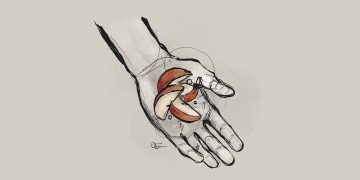PART I — WHO DO YOU THINK YOU ARE? On Identity Dysmorphia.
“I am not who you think I am;
I am not who I think I am;
I am who I think you think I am.”
— Charles Horton Cooley
Cooley’s Theory of the Looking-Glass Self
According to C. H. Cooley’s [1] theory of the looking-glass self, our self-image is built on the slivers of self-reflection we gather during our interactions with others. These social mirror dynamics produce our self-concept in three stages:
1. We imagine how others see us (based off what we perceive we present to them).
2. We imagine how others evaluate us (their judgement).
3. From these perceptions and our interpretations of their comments, reactions, and the behaviors we observe, we create our own self-belief (attributed to the sum of their suggestions).
Faulty Self-Perception
The resulting impression can be positive or negative, and the feelings we develop in consequence range from pride to shame [2] (due to our brain’s negative bias [3], the latter tends to stick better). While this is an ongoing process, most of us quickly become entrenched in quicksands of our own making. The problem is: we make terrible judges. Our interpretations are inaccurate, our perceptions faulty, and our deductions nearly always wrong. A stroll through the world of Malcolm Gladwell [4] will demonstrate just how terrible we are at reading others, which in turn plunges us into a state of what I would call Identity Dysmorphia.
The same system of self-measure shapes how we believe God sees us (I am who I think God thinks I am).
“We can make a large horse go wherever we want by means of a small bit in its mouth. And a small rudder makes a huge ship turn wherever the pilot chooses to go, even though the winds are strong. In the same way, the tongue is a small thing that makes grand speeches. But a tiny spark can set a great forest on fire.” (James 3.3-6)
The Tongue of Self-Talk
Self-talk (aka: internal dialogue/inner monologue) is how we further strengthen our own self-beliefs. It is more persistent, intrusive, and convincing than the spoken word, and operates in a self-fulfilling fashion to define our sense of identity and reality. The narrative thoughts that occupy our minds during the day not only shape how we experience life and how we experience ourselves, but also determine the actions that we take—or not—as a result.
The Woman at the Well
In John 4, Jesus engages a Samaritan woman in conversation.[5] Instantly, she questions the interaction. In the societal context of the time, she is the ultimate persona non grata: she is a Samaritan; she is a woman; and, having outlived five marriages, she is deemed immoral. She views herself as unacceptable—every failure has left her more diminished in the eyes of others and her own. She struggles to see past the lens of her self-perception, cannot understand why He addresses her, and becomes even more self-conscious when the revelations He makes show that He is a prophet. Our God is an all-seeing, all-knowing God and she feels exposed, naked before a stranger. Like Adam and Eve post-apple, her self-perception results in shame: she hides. She stands before Him as the woman she thinks He thinks she is. So do we. The closer God gets, the more our sinful nature comes into the light, the more we want to push away.
Self-Distancing — From Others and From God
In the post-2020 world of social-distancing, we stand reminded that we require connection to thrive. But a sense of self rooted in shame can easily cause us to shy away from an open, honest, and deeply intimate relationship with others as well as with God. We shrink and retreat from God because we judge ourselves to be unacceptable. Like the woman at the well, the distorted fish-eye lens of our self-perception causes us to distance ourselves. We are blind to the fact that whatever we’re convinced makes us unworthy or unforgivable has already been atoned for by the powerful blood of Christ.
Theoretically, all of us know we are forgiven. We’ve been told more than enough times. But do we truly understand it? It can be difficult for us to accept that we are loved and desired as we are, right now. How does the fact of our sinful nature (vs. Christ’s sinless perfection) fuel our doubt? Together, our faulty self-perception and the knowledge of our innate bankruptcy convince us that we need to perfect ourselves before we surrender to Him. We believe we’re not quite ready for His love—that we should somehow make ourselves more worthy of it first. But, like the Samaritan woman’s, our story does not end in shame.
How can we reconcile the seemingly contradictory truths we live with as Christians: that we are both unworthy and sinful, yet still are the recipients of His perfect love?
Check out Part Two to find out.
______
Footnotes:
[1] Charles Horton Cooley (1864-1929) was an American sociologist. He is best known for his theory of the looking-glass self and his contributions to the development of symbolic interactionism.
[2] Looking Glass Selves: The Cooley/Goffman Conjecture — “Abstract: This article reviews Cooley’s idea of the looking glass self, and Goffman’s elaboration. It can be formulated as a conjecture that links two concepts: shared awareness and the social emotions. Cooley named pride and shame as the social emotions, and Goffman added embarrassment and humiliation as shame variants. […] These hypotheses may point toward a general theory of cooperation and conflict: [vulnerability] attunement/pride holds relationships and societies together [= connection], and [lack of vulnerability] lack of attunement/shame [mortification, lit: “putting to death”] burst them apart [= isolation].”
[3] Negative thoughts and emotions can form faster than positive ones, attract our attention more easily, and be faster to recall. Our Brain’s Negative Bias — “The brain, [John Terrence] Cacioppo demonstrated, reacts more strongly to stimuli it deems negative. There is a greater surge in electrical activity. Thus, our attitudes are more heavily influenced by downbeat news than good news.”
[4] Malcolm Timothy Gladwell is an England-born Canadian author, journalist, and public-speaker.
[5] Check out Pastor Brett Hilliard’s wonderful sermon from May 23, 2021.
______
Further Reading:
– Book: “The (Honest) Truth about Dishonesty” by Dan Ariely
– Scripture: John 4; James 1-3
– Brené Brown’s TED Talk: Listening to shame































































